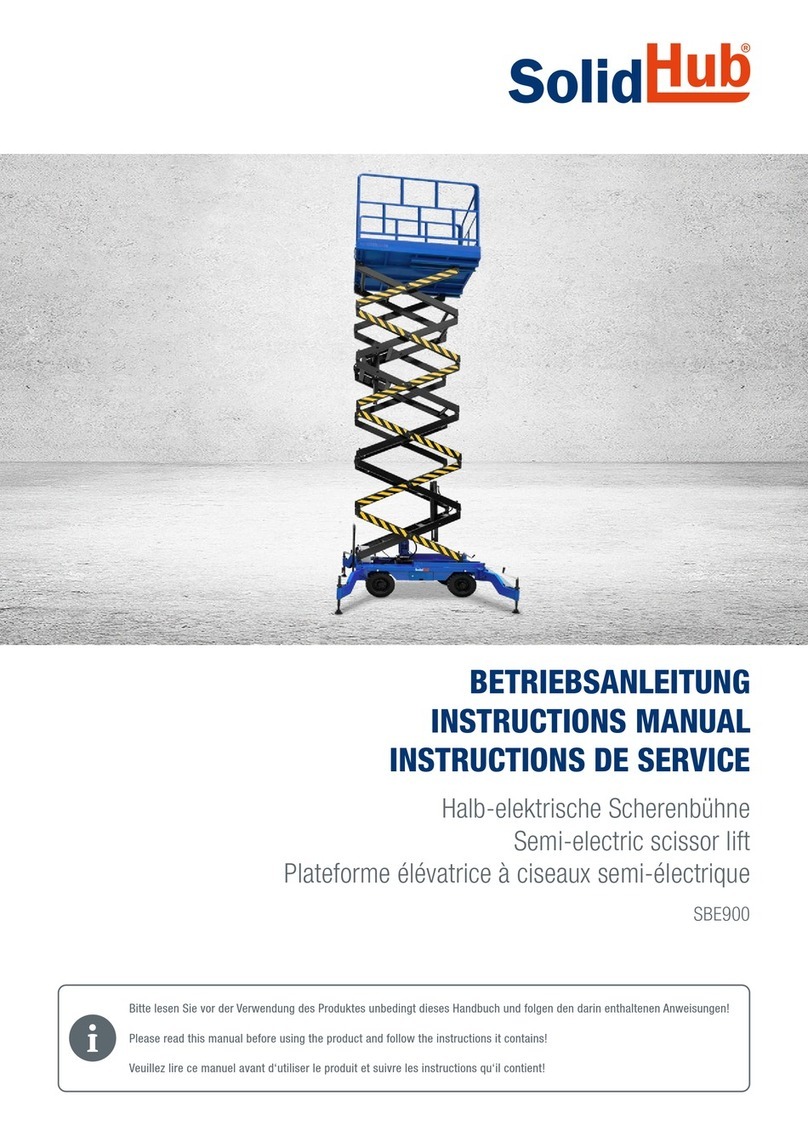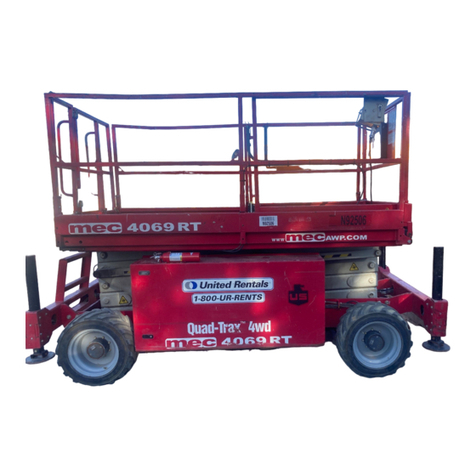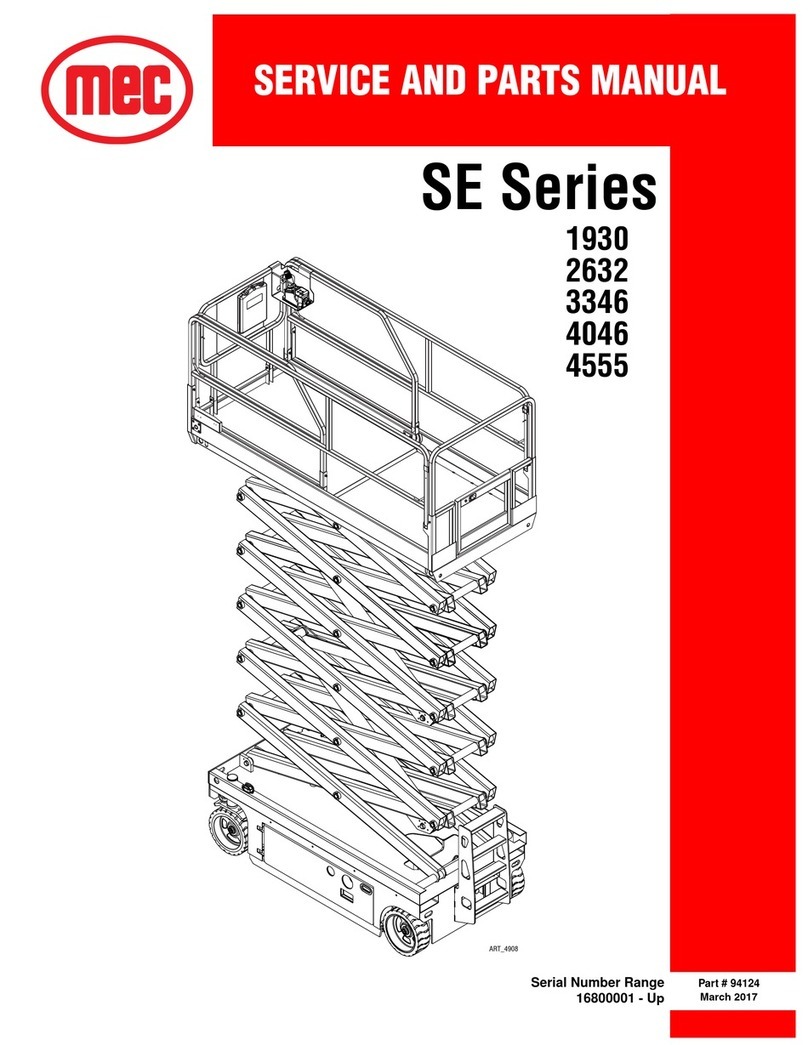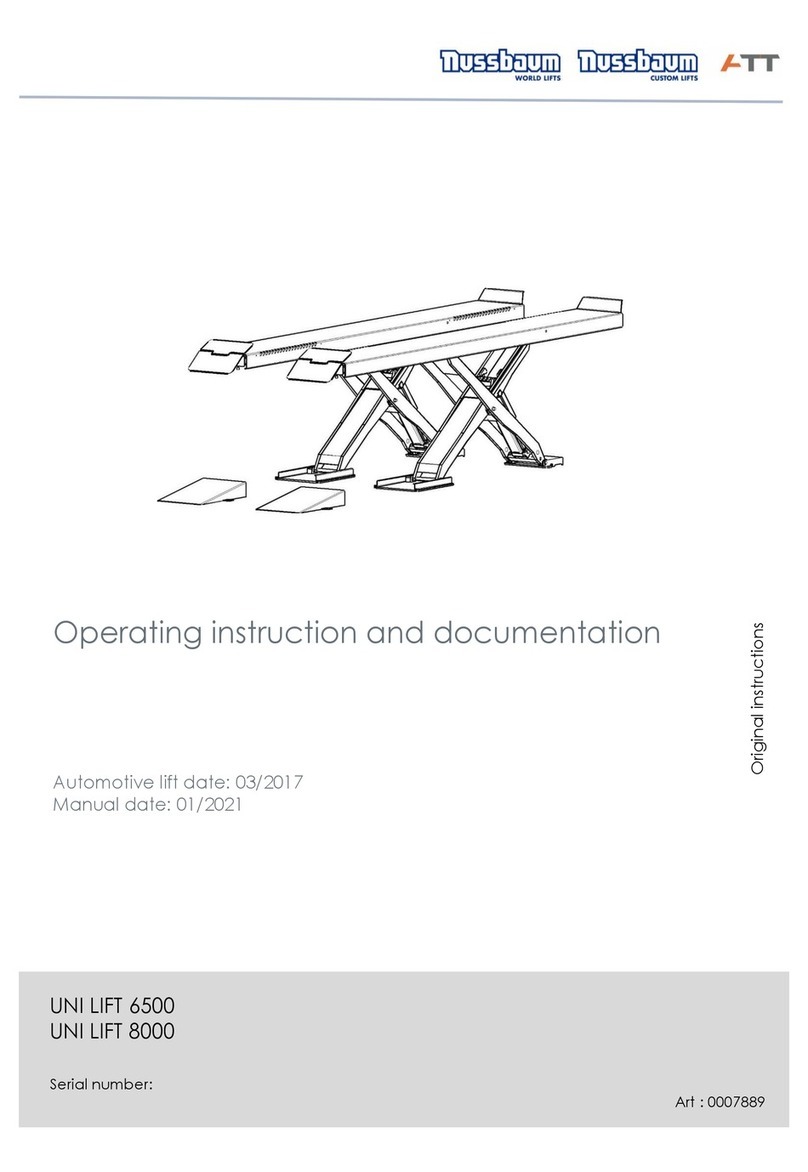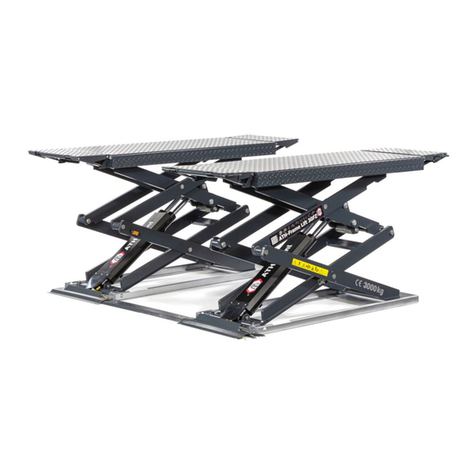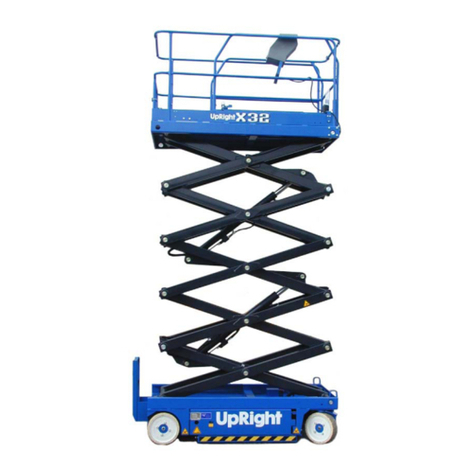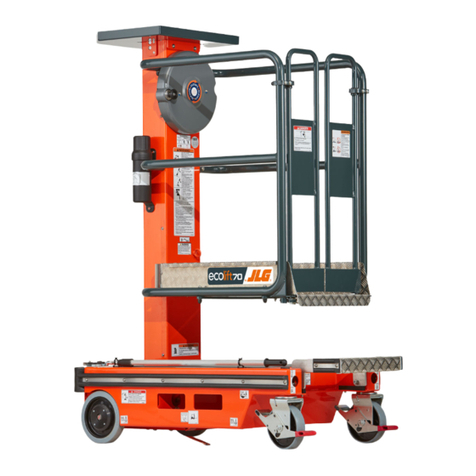
INTRODUCTION
IATTENTION
Ce manuel a été rédigé pour le personnel d’atelier affecté à l’utilisation du pont élévateur (opérateur) et
au technicien chargé de la maintenance ordinaire (agent d’entretien). Avant d’effectuer quelque
opération que ce soit sur l’élévateur et/ou sur l’emballage, il est impératif de lire attentivement
l’ensemble de ce manuel car celui-ci contient des informations importantes pour:
·LA SECURITE DES PERSONNES chargées de l’utilisation et de
la maintenance ordinaire;
·LA SECURITE DE L’ELEVATEUR;
·LA SECURITE DES VEHICULES soulevés.
CONSERVATION DU MANUEL
Ce manuel fait intégralement partie de l’élévateur et doit toujours l’accompagner, même en cas de
revente.
Il doit toujours être conservé à proximité de l’élévateur, en un endroit facilement
accessible. L’opérateur et l’agent d’entretien devront pouvoir s’y référer et le consulter
rapidement à tout moment.
IL EST EN PARTICULIER RECOMMANDE DE PROCEDER A UNE LECTURE
ATTENTIVE ET REPETEE DU CHAPITRE 3 QUI CONTIENT DES INFORMATIONS
IMPORTANTES ET DES CONSIGNES RELATIVES A LA SECURITE.
L’élévateur a été conçu et construit en conformité avec les réglementations suivantes:
DIRECTIVES EUROPÉENNES 2004/108/CE - 2006/42/CE - 2006/95/CE
NORMES TECHNIQUES
Norme européenne
EN1493-2010 - EN ISO 12100-2010
ÉQUIPEMENT ÉLECTRIQUE EN 60204-1
Le soulèvement, le transport, le déballage, le montage, l’installation et la mise en
service, le tarage ou les réglages initiaux, l’entretien EXTRAORDINAIRE, la réparation, la
révision, le déplacement et la destruction de l’élévateur doivent être effectués par les techniciens
spécialisés des REVENDEURS AUTORISES et des CENTRES DE SERVICE APRES-VENTE
AGREES par le Constructeur (voir en première page l’adresse du service après-vente agréé). Le
constructeur dégage toute responsabilité vis à vis des dommages qui pourraient être causés aux
personnes, aux véhicules ou autres objets lors des interventions citées ci-dessus si celles-ci ont été
effectuées par un personnel non autorisé, ou lors d’une utilisation de l’élévateur incorrecte ou non
prévue par le constructeur.
Pour comprendre le langage adopté dans le présent manuel, l’opérateur doit posséder
une expérience spécifique dans le domaine du travail en atelier, du service après
vente, del’entretien et de la réparation automobile, ainsi que la capacité d’interpréter
correctement les dessins et les descriptions figurant dans ce manuel et la
connaissance des normes générales relatives à la protection contre les accidents du
travail en vigueur dans le pays où l’élévateur est installé.
Les mêmes critères sont à prendre en compte pour le choix de l’agent d’entretien qui
devra, en plus, posséder les connaissances spécifiques et techniques (mécaniques,
électriques) nécessaires pour effectuer en toute sécurité les interventions prévues dans
ce manuel.
Dans les textes de ce manuel, vous trouverez souvent les termes “opérateur” et “agent
d’entretien” dont la signification est la suivante:
OPERATEUR : personne affectée à l’utilisation de l’élévateur,
AGENT D’ENTRETIEN: personne chargée de l’entretien ordinaire de l’élévateur.
EINLEITUNG
IACHTUNG
Dieses Handbuch wurde für das mit der Bedienung der Hebebühne beauftragte Werkstattpersonal
(Bediener) und für den mit der ordentlichenWartung beauftragten Techniker (Wartungsfachmann)
verfasst. Daher ist vor j dem Eingriff an der Hebebühne und/oder an dem Verpackungsmateri
andbuch zu lesen, denn es enthält wichtige Informationen für:
·Die Sicherheit der mit der dem Gebrauch und der orden tlichen
Wartung beauftragten Personen;
·Die Sicherheit der Hebebühne;
·Die Sicherheit des zu hebenden Fahrzeuges.
AUFBEWAHRUNG DES HANDBUCHES
Das Handbuch stellt ein Teil der Hebebühne dar und muss diese immer begleiten, auch wenn
sie verkauft wird Das Handbuch muss immer an einem leicht zugängliche Ort in der Nähe der
Hebebühne aufbewahrt werden. Der Bediener und die mit derWartung beauftragte Person
müssen das Handbuch jederzeit zur Verfügung haben.
INSBESONDERE WIRD EMPFOHLEN, DAS KAPITEL 3 MEHRMALS
AUFMERKSAM ZU LESEN, DENN DIESES KAPITEL ENTHÄLT WICHTIGE
INFORMATIONEN UND HINWEISE BEZÜGLICH DER SICHERHEIT.
Die Hebebühnen werden unter Beachtung der folgenden Vorschriften entwickelt
und hergestellt:
EUROPÄISCHE RICHTLINIEN 2004/108/CE - 2006/42/CE - 2006/95/CE
TECHNISCHER STANDARD
Europäischer Standard
EN1493-2010 - EN ISO 12100-2010
ELEKTRIK EN 60204-1
Heben, Transport, Auspacken, Montage, Installation und Inbetriebnahme, Eichung und
Einstellungen, AUSSERORDENTLICHE Wartung, Reparatur, Inspektion, Verschiebung und
Abbruch der Hebebühne müssen durch Fachtechniker der vom Hersteller AUTORISIERTEN
VERTRAGSHÄNDLER oder (siehe auf der Titelseite angegebenes autorisiertes Kundendienstcenter)
durchgeführt werden: Der Hersteller haftet nicht für Personen-und/oder Sachschäden, die auf die oben
beschriebenen Eingriffe zurückgeführt werden können, wenn diese Eingriffe durch nicht autorisiertes
Personal durchgeführt wurden, oder wenn die Schäden auf einen unsachgemäßen oder unzulässigen
Gebrauch der Hebebühne zurückzuführen sind.
Zum Verstehen der in diesem Handbuch angewandten Fac sprache muss der
Bediener über spezifischeWerkstatterfahrungen bezüglich Pannendienst sowie
Wartung und Reparatur von Fahrzeugen verfügen, und muss in der Lage sein, die in
diesem Handbuch enthaltenenZeichnungen und Beschreibungen zu verstehen. Ferner
muss der Bediener die im jeweiligen Aufstellland der Hebebühne geltenden
allgemeinen und spezifischen Unfallverhütungsvorschriften kennen. Die gleichen
Kriterien gelten für dieWahl desWartungstechnikers, der ferner über die spezifischen
technischen und Fachkenntnisse (Mechanik, Elektrik) verfügen muss, die zur
Ausführung der im Handbuch beschriebenen Arbeitsgänge unter sicheren
Bedingungen erforderlich sind.
Im Handbuch werden häufig die Begriffe “Bediener” und “Wartungsfachmann”
verwendet.
Diese Begriffe haben folgende Bedeutung.
BEDIENER: Für den Betrieb der Hebebühne zuständige Person.
WARTUNGSFACHMANN: Für die ordentlicheWartung der Hebebühne zuständige
Person.
INTRODUCCIÓN
IATENCIÓN
Este manual ha sido escrito para el personal de taller que se ocupa del uso del elevador
(operario) y para el técnico que se ocupa del mantenimiento ordinario (servicio) por tanto, antes
de realizar cualquier operación en el elevador y/o en su embalaje, es preciso leer atentamente
todo el manual, ya que contiene informaciones importantes para:
·LA SEGURIDAD DE LAS PERSONAS que se ocupan del uso y
del mantenimiento ordinarios;
·LA SEGURIDAD DEL ELEVADOR;
·LA SEGURIDAD DE LOS VEHÍCULOS elevados.
CONSERVACIÓN DEL MANUAL
El manual es parte integrante del elevador y debe acompañarlo siempre, aun en caso de
venta. Deberá estar cerca del elevador, en lugar fácilmente accesible. El operario y el personal
de servicio lo deberá hallar rápidamente para consultar en cualquier momento.
SE RECOMIENDA, PARTICULARMENTE, UNA LECTURA ATENTA Y
REPETIDA DEL CAPÍTULO 3, QUE CONTIENE IMPORTANTES
INFORMACIONES Y AVISOS RELATIVOS A LA SEGURIDAD.
Los elevadores han sido proyectados y fabricados respectando las siguientes
DIRECTIVAS EUROPEAS 2004/108/CE - 2006/42/CE - 2006/95/CE
NORMAS TÉCNICAS
Normas europeas
EN1493-2010 - EN ISO 12100-2010
EQUIPO ELÉCTRICO: EN 60204-1
La elevación, el transporte, el desembalaje, el montaje, la instalación y puesta en
funcionamiento, la verificación y los ajustes iniciales, el mantenimiento
EXTRAORDINARIO, la reparación, la revisión, la manipulación y el desmantelamiento del elevador
deben ser ejecutados por los técnicos especializados del REVENDEDOR AUTORIZADO o por los
CENTROS DE ASISTENCIA AUTORIZADOS del Fabricante (ver centro de asistencia autorizado
indicado al principio).
El fabricante no responde de daños a personas, vehículos u objetos causados por las
intervenciones antes citadas si se han efectuado por personal no autorizado o por un
uso impropio o no consentido del elevador.
Para comprender el lenguaje usado en este manual, el operario debe tener experiencia
específica en las actividades de taller, de asistencia, mantenimiento y reparación de
vehículos así como la capacidad de interpretar correctamente los dibujos y
descripciones indicades en el manual y el conocimiento de las normas preventivas
generales y específicas vigentes en el país donde se instala el elevador.
Idénticos criterios son válidos para la elección del técnico de mantenimiento que
deberá, además, poseer los conocimientos específicos y de especialización
(mecánico, eléctrico) necesarios para realizar con seguridad las intervenciones
previstas en el manual.
En el texto del manual se encontrará a menudo las frases “operario” y “personal de
servicio” cuyos significados son los siguientes:
OPERARIO: persona que se ocupa del uso del elevador.
PERSONAL DE SERVICIO: persona que se ocupa del mantenimiento ordinario
del elevador.
6





